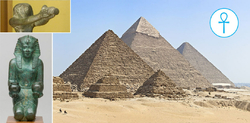- Retour accueil
- Vous êtes ici : Blog The Pyramids of the Cold The Pyramids of the Cold Section 11 • The Grand Gallery is the Hidden Hauling Cavern of the Underworld
The Pyramids of the Cold Section 11 • The Grand Gallery is the Hidden Hauling Cavern of the Underworld
Publié par Bruno Coursol dans The Pyramids of the Cold le 12/04/2022 à 20:09

The Pyramids of the Cold - Section 11 • The Grand Gallery is the Hidden Hauling Cavern of the Underworld
In summary : the Underworld Amduat "Book of the Hidden Chamber" is describing the endless Hauling process of the impactor of the Great Pyramid of Giza inside the Grand Gallery.
• The Underworld is a metaphoric representation of the chambers and passages of the Great Pyramid of Giza : the Grand Gallery, the inclined well (the ascending passage), the horizontal cooling passage and the Queen's chamber.
• The zigzag Hauling of the Solar Barque in the Land of Sokar, constantly blocked in its progression is a metaphor of the progression of the towing of the impactor in stages, latch bolt after latch bolt, 25 times per cycle.
• Sokar is a metaphor of the latch bolts themselves
• Aker, the "god of the Horizon", represented most of the time as a pair of lions, is actually referring to the axle beam and its two eastern and western holders.
This post is about the operating cycle of the Grand Gallery and its metaphoric glorifying representation in the Amduat, the "Book of the Hidden Chamber", as well as its personification in
We'll see that the "Sacred place of Hauling" was the Grand Gallery of the pyramid.
We'll see that the Land of Sokar is referring to the operation of the latch bolts that enabled the progression of the wooden gantry structure, inside which 8 crewmembers were towing the impactor. Sokar being the glorifying representation of the latch bolts.
We'll see that the Rosetau region was referring to the eastern and western benches of the gallery where the crewmembers were operating the beetle and hauling the impactor.
We'll see that the ancient Egyptian "God of the Horizon", Aker (Akeru, plural), was referring to the axle beam and the 3 ropes that were used for the hauling.
We'll also see that the so called "Hidden Chamber" was the Queen's chamber, the only chamber of the Great Pyramid located on its central axis, the chamber where all the efforts of the Great Pyramid operation were concentrated : the storage of the evaporative cold, and most probably the start of its use for the natron manufacturing cooling process.
Most excerpts about the Amduat are coming from Wikipedia : https://en.wikipedia.org/wiki/Amduat , RCT : https://www.rct.uk/collection/1145263/section-of-the-papyrus-belonging-to-nesmin-with-the-fourth-hour-of-the-amduat and Sofiatopia for the huge amount of raw data (and obvioulsly not their interpretations of the Amduat) : http://www.sofiatopia.org/maat/hidden_chamber03.htm
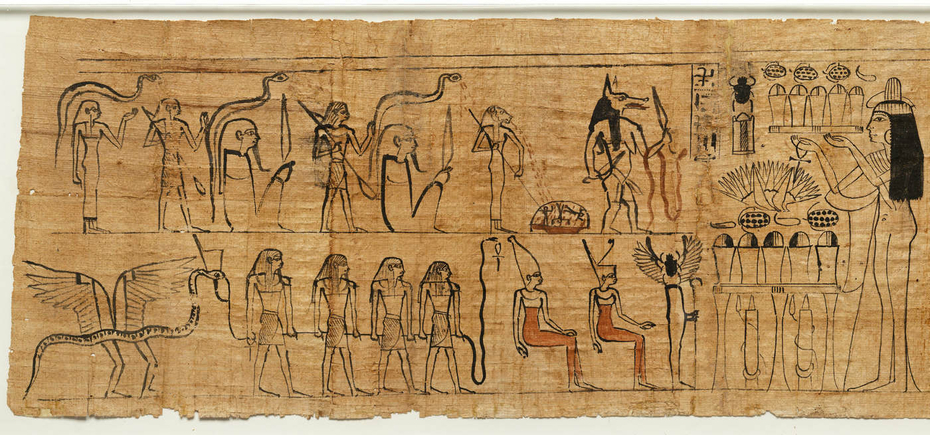
Amduat Papyrus Inscribed for Tiye from the Metropolitan Museum of Art, New-York ; Accession Number: 25.3.33 (ca. 975–945 B.C). https://www.metmuseum.org/art/collection/search/549650
11.01 The Amduat (the "Book of the Hidden Chamber") is the story of god Ra through the Duat-Underworld
"The Amduat, literally "That Which Is In the Afterworld", also translated as "Text of the Hidden Chamber Which is in the Underworld" and "Book of What is in the Underworld"; is an important ancient Egyptian funerary text of the New Kingdom of Egypt. Like many funerary texts, it was found written on the inside of the pharaoh's tomb for reference. Unlike other funerary texts, however, it was reserved only for pharaohs (until the Twenty-first Dynasty almost exclusively) or very favored nobility."
"It tells the story of Ra, the Egyptian sun god who travels through the underworld, from the time when the sun sets in the west* and rises again in the east*. It is said that the dead Pharaoh is taking this same journey, ultimately to become one with Ra and live forever."
"The underworld is divided into twelve hours of the night, each representing different allies and enemies for the Pharaoh/sun god to encounter. The Amduat names all of these gods and monsters. The main purpose of the Amduat is to give the names of these gods and monsters to the spirit of the dead Pharaoh, so he can call upon them for help or use their name to defeat them."
*Sunset is symbolising death, and sunrise is symbolising rebirth.
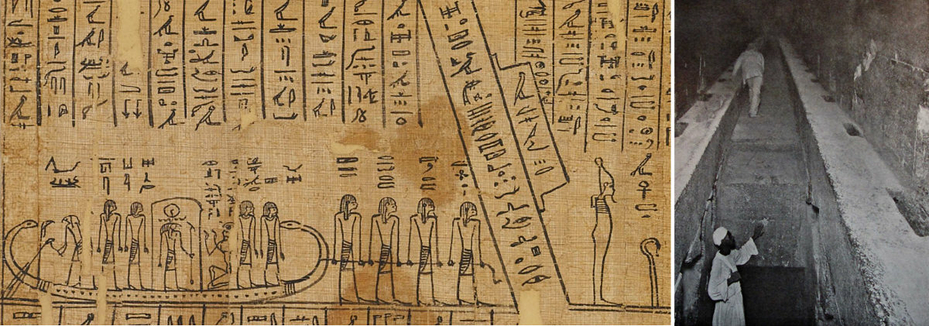
The Amduat, literally "That Which Is In the Afterworld", also translated as "Book of the Hidden Chamber Which is in the Underworld" and "Book of What is in the Underworld"; is an important ancient Egyptian funerary text of the New Kingdom of Egypt. Section of the papyrus belonging to Nesmin, with the fourth hour of the Amduat. Papyrus from The Royal Collection Trust, c.300-275 BC. RCIN 1145263. https://www.rct.uk/collection/1145263/section-of-the-papyrus-belonging-to-nesmin-with-the-fourth-hour-of-the-amduat
11.02 The Underworld is referring to the chambers and passages of the Great Pyramid
The real hidden meaning of the Underworld is about most of the inside layout of the Great Pyramid of Giza : the Grand Gallery, the inclined well (the ascending passage), the horizontal cooling passage and the Queen's chamber.
I've already approached the Duat-Underworld in the post about Apep, and I've said that the Underworld was a representation of the inclined well, but I was wrong : the inclined well is only a part of the Underworld.
At the time when the Great Pyramid was operating, meaning that cold was produced in its Lower part and used on its Upper part, where the Solvay reaction chambers were (most probably) set and needed to be cooled down, the main activity was on this particular Upper part : on the "flat roof" of the pyramid.
That was on that level that the master engineers, contractors and site managers (most probably) had their headquarters. So everything underneath this level is what have been called "the Underworld", and that includes the Grand Gallery, the inclined well (the ascending passage), the horizontal passage and the Queen's chamber.
We'll see on the Amduat Hour 5, that the Queen's chamber was the Hidden Chamber.
11.03 The Grand Gallery and the Inclined Well in the Amduat
In Hour 4 of the Book of the Hidden Chamber (the Amduat), the "sloping passageways" of an "oval-shaped cavern" are described as "the mysterious paths of the place of Hauling".
"In the fourth hour of the Amduat, Re enters a dark and dry new region called Rosetau, meaning 'act of towing'. His solar bark is indeed depicted as being towed by four gods over a dry, sandy land populated by snakes. The solar bark itself has been transformed into a double-headed serpent as only snakes can successfully get across this desert and dangerous region."
In these particular excerpts, everything is about the Grand Gallery and/or the inclined well :
• The "sloping passageways" are referring to the Grand Gallery and to the inclined well
• The "oval-shaped cavern" is referring to the Grand Gallery alone, and is about its shape
• The "dark and dry new region called Rosetau" is referring to the Grand Gallery alone and is about its environment
• The "mysterious paths of the place of Hauling" is referring to the Grand Gallery alone, and is about its function
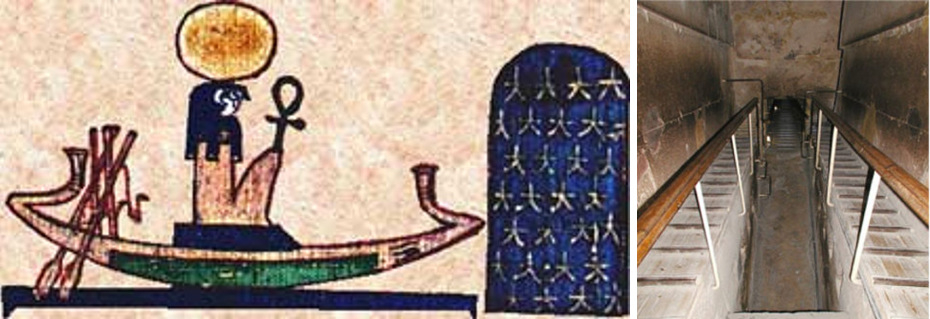
The "sloping tunnel of the underworld" in the ancient Egyptian Amduat Book of the Hidden Chamber, is a metaphorical representation of the inclined well of the Great Pyramid of Giza.
11.04 The representation of the inclined well in the Amduat : "the sloping tunnel of the underworld"
The inclined well of the Great Pyramid of Giza was represented in the Amduat "Book of the Hidden Chamber of the Underworld", as the "sloping tunnel of the Underworld" : "during the night the sun journeyed through a tunnel that existed in the earth - its entry into the tunnel caused the night, its emergence again bringing the day once more." http://www.touregypt.net/godsofegypt/aker.htm

Detail of the Amduat Papyrus Inscribed for Tiye from the Metropolitan Museum of Art, New-York ; Accession Number: 25.3.33 (ca. 975–945 B.C). https://www.metmuseum.org/art/collection/search/549650
11.05 The Hauling in action and producing the cold
The above scene of the Amduat is another evidence, or clue, that Sokar is the representation of the latch bolts. What we have here is the schematic metaphoric representation of the towing beetle, with the 3 major elements of the operating :
• the snake as a representation of the water that descends the slope both in the central gutter for the impactor to move, but also for the water that were used inside the hollow section rails in which the Hauling Beetle sledges were moving.
We know that the water (the snake) was in motion, because it is walking on a pair of legs.
• the 4 crewmembers that were operating each one of the Beetle units, one on each ramp of the Gallery
• and the 2 wings of Sokar, the latch bolts, the "knives" that were cutting the progression into pieces.
Please note that these 2 wings aren't just wings : some structures are clearly marked, of course I am seeing into them the niches of the eastern and western walls. These niches were the cavities where the latch bolts were retracted in by the Hauling Beetle.
Also we can see that the big snake on legs is prolonging itself into a smaller snake, with no legs, but which is offering the ankh sign instead. In other words, the scene can be translated as follows : the Hauling process is the one producing the evaporative cold (the Ankh sign is the evaporative cold).
.
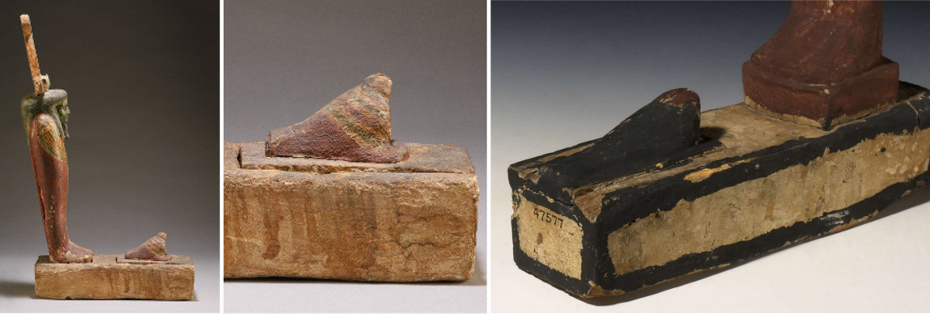
The zigzag Hauling of the Solar Barque, constantly blocked in its progression is a metaphor of the progression of the towing of the impactor in stages, latch bolt after latch bolt, 25 times per cycle.Ptah-Seker-Osiris figures showing the squatting falcon representation of god Seker (Sokar), put onto the wooden base of the figure. The general shape of that falcon is most probably representing the latch bolts that were inserted inside the niches of the eastern and western walls of the grand gallery of the Great Pyramid of Khufu.
Left : figure of Ptah-Sokar-Osiris 86.1.88a–d, ca. 600–525 B.C. from the Metropolitan Museum of Art, New-York (Late Period, Saite) https://www.metmuseum.org/art/collection/search/551504. Right : painted wooden figure of Ptah-Sokar-Osiris EA47577 excavated in Asyut, from the British Museum (664BC-305BC), https://www.britishmuseum.org/collection/object/Y_EA47577
11.06 The Land of Sokar is referring to the progression in stages of the towing of the impactor
The zigzag Hauling of the Solar Barque in the Land of Sokar, constantly blocked in its progression is a metaphor of the progression of the towing of the impactor in stages, latch bolt after latch bolt, 25 times per cycle.
Still about the Amduat Hour 4 : "The zigzag path, repeatedly closed by doors, gives access to the 'Land of Sokar, who is upon his sand', which Re visits during the fourth and fifth hours."
Once again, ancient Egyptians used the knife as a metaphor : the hauling process of the impactor, enabled or limited by the latch bolts apparatus, was performed in stages, latch bolt after latch bolt.
To reinforce that idea, many representations of Sokar are showing a very distinctive triangular shape, the exact same shape as a regular modern latch bolt.

Detail of the Book of the Dead of the Priest of Horus (section 2), Imhotep (Imuthes), ca. 332–200 B.C. from the Metropolitan Museum of Art, Accession Number: 35.9.20a–w : https://www.metmuseum.org/art/collection/search/551786
11.07 The pair of Sokar representations, facing each other to refer to the pair of latch bolts per stage
This part of the Book is particularly interesting because the falcon representation of Sokar is represented 2 times. The first one is on the left, and Sokar appears in a triangular shape exactly like in the Ptah-Sokar-Osiris figures (except the 2 additional spread wings), but the second one is what's really worth looking at : here, Sokar is represented twice and both are facing each over; there is no more wings, but their legs are somehow suggesting that same 45° angle that many squatted falcons of Sokar representations are showing.
That facing representation of that "double Sokar" reinforce one more time the idea that Sokar is a metaphor of the pairs of latch bolts that were facing each other themselves.
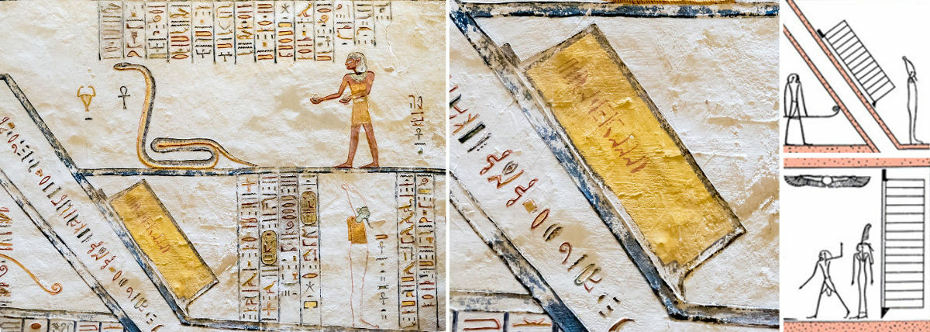
Tomb KV 9 of Ramesses V-VI, corridor H Amduat Hour 4, photographed by Kairoinfo4U and posted on flickr : https://www.flickr.com/photos/manna4u/38745537034/in/photostream/
11.08 The inverted position of the latch bolts in the hauling beetle scarab of the Amduat
On the reliefs of the Amduat Hour 4 on the above image, both the impactor and the beetle hauling scarab are represented. We've already seen in the post on Apep that the solar barque was a metaphor of the impactor, and here also appears the metaphoric representation of the hauling scarab, and that is the rectangular structures going down the slope.
If we look at the enlarged image of the structure, it is like hanging in mid air by some kind of magic trick. But actually the trick is also depicted : that is the triangular black shape that is holding the entire structure.
The triangular black shape is the latch bolt.
So why did they represented the latch bolts on the bottom side of the scarab structure, while I'm positioning them on the upper side? Well, they are 2 possibilities :
1 • I am wrong about the way that the towing scarab was operating the axle beam, and it is a very legitimate possibility as I am everything but an engineer myself…
2 • I am right about this part, and the explanation could be as follows : on these reliefs, the ropes and the axle beam aren't depicted, there are just the structures on "the slopping paths of the towing region", and that makes another story where nobody would have ever understand that some "triangular stopping elements" would have been put on the upper part of the structure.
I've only put the latch bolts on the upper side of the structure because the axle beam would have redirected the towing forces 180°. The axle beam is inverting the towing forces. So on the reliefs, if the story is "some structure was going down the slope, one step at a time in a constant cutting progression by some kind of "knives" in a "zigzag" movement, well what do you do about the latch bolts : you put them on the lower side of the towing structure, so that the progression still appears logical and secure.
11.09 Is the Fire-Water the pressurized water or the cold itself ?
"This Lake of Fire is a place of fiery punishment for the damned, but the blessed dead drink cool water from it. This "fire-water" is a powerful alchemical symbol, related to Philosophical Mercury (Aqua Mercurii). Dependent on one's attitude and condition, this water changes function. Constructive (blue) to some, it is destructive (red) to others."
As of today, I'm not sure of the true meaning of the fire-water. No doubt it is another metaphor, but is it about the pressurized water or about the cold water itself?
11.10 Is the "who is upon his sand" reference another metaphor of the stop-and-go progression ?
It is still unclear to me what is the meaning of this "sand" reference. The only sand I could think of in this part of the Great Pyramid is the sand filter that was set in what is used today as an electrical room, located between the top platform and the antechamber, on the western side.
In my opinion, this sand filter was most probably a bio-sand filter, able to produce large amount of drinkable water from the dirty water tank that was the King chamber. But I don't see why Aker (the two axle beam holders set in the eastern and western holes), would have been described as "who is upon his sand".
But most probably, this sand reference could be another metaphor of the zigzag progression : when you are walking on sand, the progression is difficult and slow and most of the time it is impossible to walk straight. So that sand could be just another metaphor here, the same way the gates, or the doors are : the operating of the Hauling Beetle was hard, slow and in an endless stop and go progression.
11.11 The start of the cold production
In the Amduat, the "Book of the Hidden Chamber", it is said that the process of regeneration, meaning the cold production, starts at the end of the fourth hour, and that corresponds with the deepest and darkest point of RA's voyage.
That deepest and darkest point is about the grand gallery ; as soon as the impactor enters the inclined well, its water is pressurized and the cold can be made : "Arriving at the deepest, darkest point (the end of the 4th Hour), attention is brought on the process of regeneration itself (the 5th & 6th Hour)."

God Aker (Akeru, plural). Drawing by Jeff Dahl : "Aker, an ancient Egyptian personification of the horizon. Two lions symbolize 'yesterday' and 'tomorrow' with the sun-disk rising between the symbolic horizon between them. The hieroglyph for 'sky' spans across the top. Based on New Kingdom tomb paintings and the book of the dead." https://en.wikipedia.org/wiki/Aker_(deity)#/media/File:Aker.svg
11.12 God of the "Horizon" Aker : the academic point of view
The Amduat Hour 5 introduces Aker, the "god of the Horizon". Represented most of the time as a pair of lions, Aker is actually referring to the axle beam and its two eastern and western holders.
"In Egyptian mythology, Aker (also spelt Akar) was one of the earliest gods worshipped, and was the deification of the horizon. There are strong indications that Aker was worshipped before other known Egyptian gods of the earth, such as Geb. In particular, the Pyramid texts make a sinister statement that the Akeru (plural of "Aker") will not seize the pharaoh, as if this were something that might have happened, and was something of which to be afraid. "Aker" itself translates as "(one who) bends", and thus "Akeru" translates as "benders", though in what sense this is meant, is not fully understood. […] these heads were usually those of lions. Over time, the heads became full figures of lions (still facing away from each other), one representing the concept of "yesterday" ("Sef" in Egyptian), and the other the concept of "tomorrow" ("Duau" in Egyptian)."
"As the horizon, Aker was also seen as symbolic of the borders between each day, and so was originally depicted as a narrow strip of land (i.e. a horizon), with heads on either side, facing away from one another, a symbol of borders."
Source : https://en-academic.com/dic.nsf/enwiki/59798
Above the lions, are supposed to be the horizon (white), ended by mountains (colored pikes), the red sun and the blue sky (blue straight).

Menat necklace from Malqata at the Metropolitan Museum of Art, New-York (left and center) 1390–1353 B.C. New Kingdom, Dynasty 18. Reign of Amenhotep III, https://www.metmuseum.org/art/collection/search/544509. Right : the same necklace, photographed by Eric (Wsrmatre Stpnre) and posted on Flickr, https://www.flickr.com/photos/wsrmatre/40919418864
11.13 God of the "Horizon" Aker is referring to the axle beam and its pair of holders
Aker is often depicted as a pair of lions, looking east and west and clearly holding something on their backs. To understand the real meaning of this, we need to look at the Menat Necklace from Malqata at the Metropolitan Museum of Art : what is important in the pair of lion (or cat) representations isn't their backs, but the hole between their paws and their bellies. The Menat necklace clearly indicates that a "beam" was supposed to be inserted through the cat bellies.
If we look closely the above center photograph, two thin parallel straight lines are even materializing the exact position where the axle beam was intended to be.
These same cats are also looking east and west and their general shape seems to have been designed to perfectly fit in the eastern and western holes of the top platform of the Grand Gallery.
To understand the link between the pair of opposite cats (or lions), we need to look at some figures of the Four Sons of Horus.
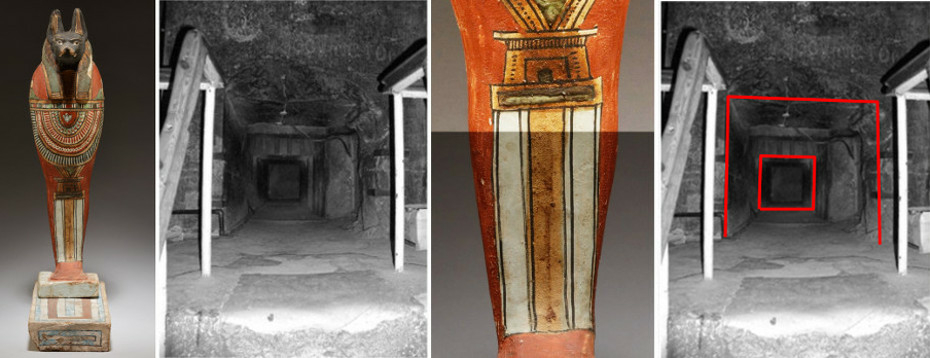
Image on the left and center : Funerary Figure of Duamutef. 400–30 B.C. Late Period–Ptolemaic Period. The Metropolitan Museum of Art, New-York. On view at The Met Fifth Avenue in Gallery 133. https://www.metmuseum.org/art/collection/search/551149
11.14 The Grand Gallery layout replica on the Four Sons of Horus figures at the MET
The first photograph is one of the Four Sons of Horus figures, visible at the Metropolitan Museum of Art at New-York, and is showing a jackal-headed figure representing Duamutef, the god who protected the stomach of the mummies.
The half lower part of this image had been magnified and partially enlightened on the second picture of the figurine so that we can see clearly the different structures depicted.
My assumption is that what we have here is a complete representation of the grand gallery layout of the Great Pyramid of Khufu :
1/ The eastern and western ramps (painted white), with 2 hollow section rails by ramp
2/ The central gutter (yellow painted)
3/ The top platform (yellow painted), with the axle beam for operating the 3 ropes
4/ The south wall of the grand gallery (with the openings)
5/ The opening of the antechamber (black line)
6/ The opening of the passage to the King's chamber (black square)
In my opinion, the crucial element here is the one that is represented in a greenish color and that seems to be put onto the top platform. That element is the axle beam.

Funerary Figures of the Four Sons of Horus, with Imsety (human head) second from the left. 400–30 B.C. Late Period–Ptolemaic Period. The Metropolitan Museum of Art, New-York. Imsety is the only one with a human head, the three other Sons of Horus figures have heads representing a jackal (god Duamutef), a baboon (god Hapy) and a falcon (god Qebehsenuef). https://www.metmuseum.org/art/collection/search/564551
11.15 The axle beam for operating the 3 ropes of the gallery was inserted into the 2 holes of the platform
The second magnified image is from the figurine of Imsety, the god that protected the liver, and who was one of the Four Sons of Horus. This image clearly shows the eastern and western holes of the platform and it also depicts that the greenish element was "inserted" inside these holes.
This Imsety figurine is telling us that the main axle beam on which the 3 ropes of the grand gallery were attached to, was anchored into the platform. Also, it is crucial to really keep in mind that this platform is way bigger that what we can see in the first place : it is one of the biggest stone of the entire structure of the pyramid.
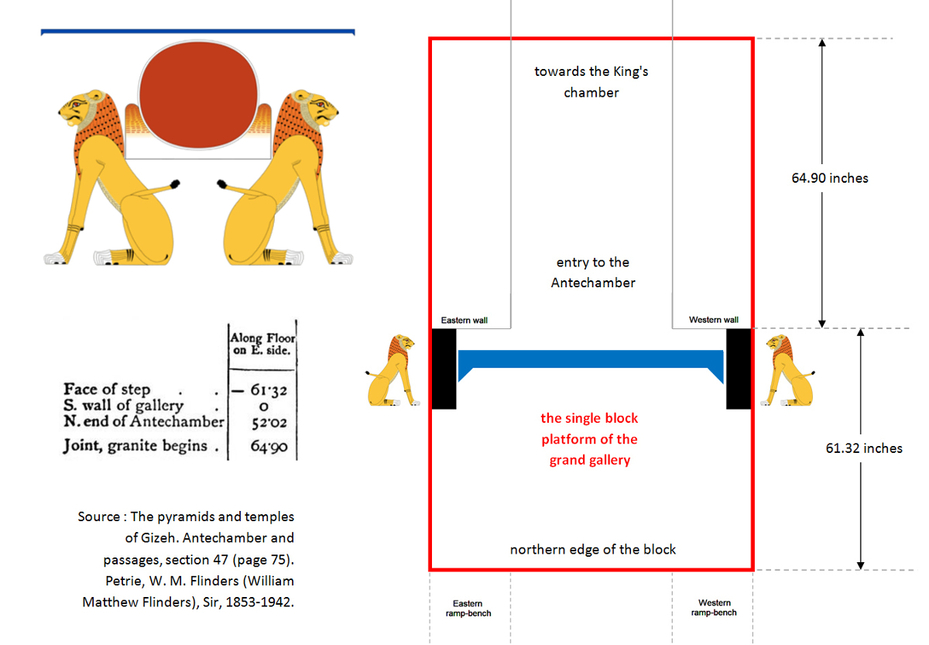
The southern part of the single block that formed the top platform of the grand gallery, was under tremendous charge by the structure weight, that perfectly anchored the block. It was necessary to resist to the huge structural stress induced by the endless operating of both the beetle wooden scarab, and the moving caisson. God Aker (Akeru, plural), drawing by Jeff Dahl : https://fr.wikipedia.org/wiki/Aker#/media/Fichier:Aker.svg
11.16 The single block platform of the grand gallery
The top platform of the Grand Gallery has a very specific design, because it is actually made of one single giant block, that goes way after the south wall of the gallery towards the antechamber : the block is way bigger than what we can see of it, exactly like it is for the girdle stones of the inclined well.
Charles Rigano mentioned : "The single block forming the Step does not stop at the Gallery wall but extends an additional 66 inches* into the Ante Chamber".
* For Petrie, it was 64.90 inches. Source : The pyramids and temples of Gizeh. Antechamber and passages, section 47 (page 75). Petrie, W. M. Flinders (William Matthew Flinders), Sir, 1853-1942. https://archive.org/details/cu31924012038927/page/n113/mode/2up
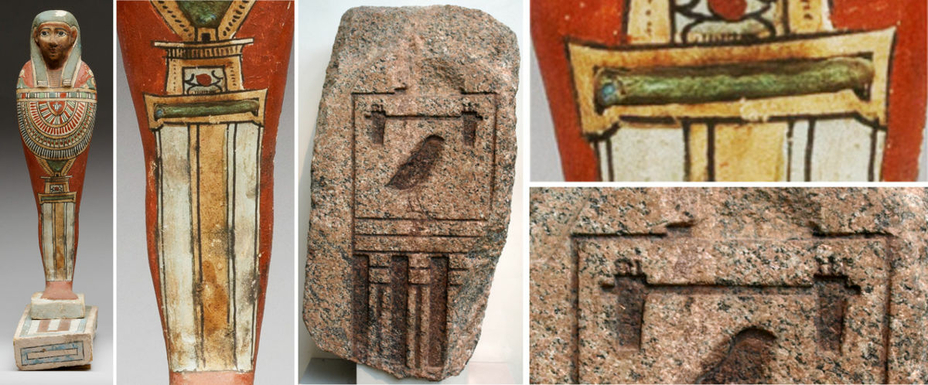
Funerary Figure of Imsety, one of the Four Sons of Horus (with human head) from The Metropolitan Museum of Art, New-York, 400–30 B.C. Late Period–Ptolemaic Period (Accession Number: 12.182.37b). Granite fragment with Khufu's Horus name Medjedu on it from the British Museum, photographed by CaptMondo and posted on Wikipedia (en).
https://www.metmuseum.org/art/collection/search/564551
11.17 The axle beam of the Great Pyramid of Giza (with its pair of holders), on a granite fragment with Horus' name of Khufu on it
A better representation than the one found on the Imsety figure, can be found on the granite fragment with Khufu's Horus name at the British Museum : the axle beam and its holders are perfectly drawn on what looks like the exact same top platform of the Grand Gallery.
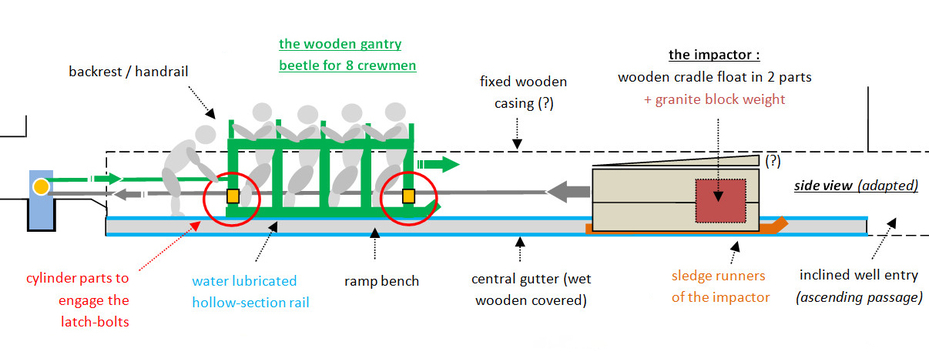
The entire Lower Pyramid cooling process started in the grand gallery of the Great Pyramid with the operating of the axle beam and the 3 ropes that were attached to the wooden beetle scarabs (one on each ramp), and the impactor (in the central gutter).
The maneuvering of the axle beam allowed the impactor to get inside the inclined well (the underworld).
From Academic.com : "Aker was said to guard the entrance and exit to the underworld, opening them for the sun to pass through during the night. As the guard, it was said that the dead had to request Aker to open the underworld's gates, so that they might enter." Source : https://en-academic.com/dic.nsf/enwiki/59798
Here again, everything is nothing else than metaphors : there is no door to open to get to the Duat-Underworld, but you had to operate the ropes and the axle beam has to be in action, rotating in both ways.
11.18 "Yesterday/Tomorrow" : the forwards and backwards references to the axle beam direction of rotation
"From Middle Kingdom onwards Aker appears as a pair of twin lions, one named Duaj (meaning "yesterday") and the other Sefer (meaning "tomorrow"). Aker was thus often titled "He who's looking forward and behind". https://en.wikipedia.org/wiki/Aker_(deity)
"In the later period of Egyptian theology the two lions making up the Akeru were named Sef and Tuau - 'yesterday' and 'today' respectively." http://www.touregypt.net/godsofegypt/aker.htm
That reference to yesterday and tomorrow (or today) is in y opinion echoing the fact that the axle beam was operated in both directions of rotation : both the towing scarab and the impactor were moving forwards and backwards, again and again, day after day.
My interpretation of the operating of the 3 ropes as represented on the above drawing, isn't probably the only solution to get the job done, but it is simple and could be sufficiently efficient to be correct. It doesn't require any pulley, and according to scholars, ancient Egyptians didn't use this kind of equipment at the time of the construction of the pyramids.
The forwards and backwards reference is about the perpetual direction of rotation changes of the axle beam.
11.19 The axle beam that bends and imprisons the coils of the snake
It is known that the name Aker means "(one) who bends", and it is conceivable to imagine that the axle beam would indeed bend a lot. Maybe one day we'll even find out in what wood that beam was made of, like we know that the impactor was made out of Sycamore tree wood.
That reference to the bending of Aker is easy to apprehend, and maybe the reference to the coils of the snake imprisoning is that easy : it could simply refer to the winding of the ropes on the axle beam.
"More importantly, he imprisons the coils of the snake, Apophis (Apep), after it is hacked to pieces by Isis, and Aker could, along his back, provide a secure passage for the sun-god's boat as it traveled from west to east during the hours of the night." http://www.touregypt.net/godsofegypt/aker.htm
"The name Aker means '(one) who bends'". https://ancientegyptonline.co.uk/aker/
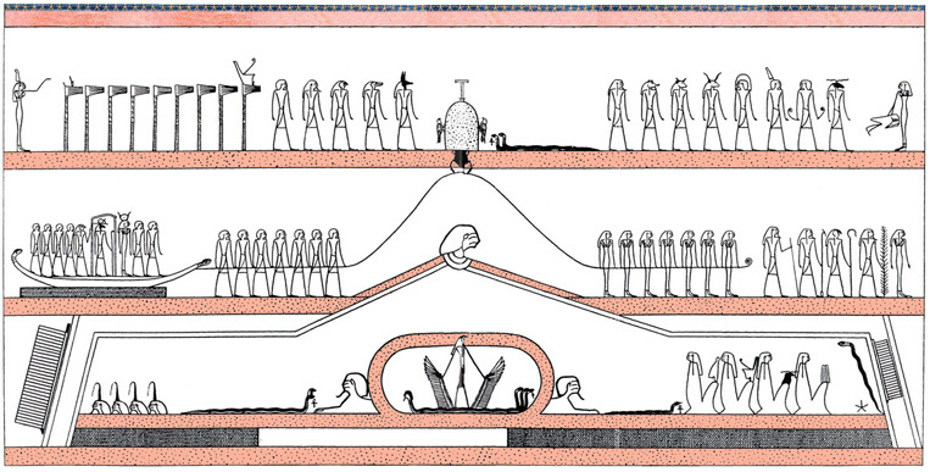
The Amduat Book of the Hidden Chamber, Hour 5. Burial chamber of the tomb of Pharaoh Tuthmosis III - ca. 1426 BCE. Drawing by A.G. Shedid (digitally enhanced) - Hornung (1999).
11.20 The "grasp of the Akeru" and the hazardous work reference about the winding of the ropes
Until now, we haven't discussed at all about the danger that were facing the crewmembers of the wooden beetle scarab. When they were inside the gantry, they most probably didn't risk anything : their work would have been excruciating but not that dangerous.
I suggested the idea that when the impactor was at the top of the gallery, ready to be released in the slope, the crewmembers first had to get the wooden gantry lifted back up as well, so that the entire crew would most probably be on the top platform just before releasing the impactor.
I also suggested that one crewmember on each ramp was on the top platform, hauling the ropes of the gantry while the 4 other crewmen, on each ramp, were pushing the beetle back up.
During these two phases of operating, crewmen would have been close to the axle beam while the ropes would have been winded on, and they would certainly have fear the danger of their hands being grasped by the ropes winding on the axle :
"Later the Egyptian priests created magical spells to protect ordinary mortals from the grasp of the Akeru, the primeval, lion earth gods." https://www.landofpyramids.org/aker.htm
"There was also a more threatening side to Aker that can be seen when he is pluralized as Akeru in the form of multiple earth gods. In passages from the Pyramid Texts, the Akeru are said not to seize the monarch, but later there is a general hope for everyone to escape the grasp of the earth gods." http://www.touregypt.net/godsofegypt/aker.htm
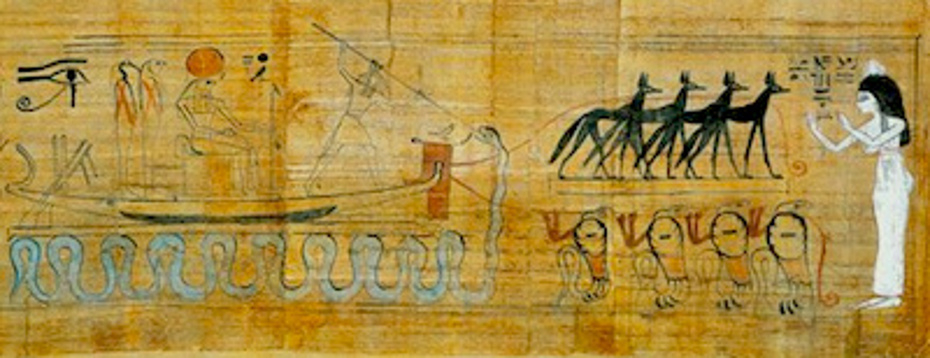
Apep (also Apophis) was the ancient Egyptian Great Serpent god of Chaos ("isfet") that reigned over the Underworld and fought sun and creator god Ra in his solar barque, in endless fights, night after night. Image from Soutekh67 and posted on Wikimedia Commons : https://commons.wikimedia.org/wiki/File:Barque_solaire_contre_Apopi.jpg
11.21 The protection from the Great Serpent Apep and the snake bite immunity
"He guarded the eastern and western borders of the netherworld and protected the sun god Ra when he first entered the netherworld at sunset and again when he returned to the world of the living at sunrise and bore the sun on his back through the underworld. He also welcomed the dead Pharaoh into the underworld."
"He defended the sun god from the serpent Apep (Apophis) and was considered to be able to neutralize a snake bite. In his role as a protective deity, twin lion statues representing Aker were placed at the doors of palaces and tombs to protect against evil spirits, a practice adopted by both the Greeks and Romans."
This part is absolutely essential because it links the Akeru (the axle beam and its holders) to the inclined well (pressurized) waters (the Great Serpent Apep).
Aker was the metaphor of the equipment that used the energy of the working crew of the beetle scarab to lift, again and again the impactor on top of the gallery, before its release in the slope.
When the impactor hits the waters of the well, it could be described as an attack on that waters, an attack on Apep.
Also, when the impactor is recovered from the well for another cycle to begin again and again, it could be depicted as some kind of immunity from Apep ; hence the reference to the snake bite : "He defended the sun god from the serpent Apep (Apophis) and was considered to be able to neutralize a snake bite."
No matter how many times Aker attacked Apep, he would always be able to safely escape from Apep's grip, unharmed.

Detail of The Amduat Book of the Hidden Chamber, Hour 5. Drawing by A.G. Shedid (digitally enhanced) - Hornung (1999). Burial chamber of the tomb of Pharaoh Tuthmosis III - ca. 1426 BCE.
Detail of the Amduat "Book of the Hidden Chamber" Hour 5, showing the oval cavern of the Land of Sokar (the Grand Gallery), with god Sokar spreading or opening wings from the ground, inside the cavern, that is "closed" by two lions, facing east and west. These two lions represent the god Aker (Akeru in its plural form).
This scene is a metaphorical representation of the grand gallery of the Great Pyramid of Khufu. The two doors (the lions), that were "closing" the Land of Sokar, were a metaphor of the representation of the axle beam and its two eastern and western holders that were set onto the Grand Gallery's top platform : what was allowing the solar barque to get in the tunnel of the Underworld, were precisely what represent god Aker : the axle beam and its two eastern and western holders.
The two lions were controlling the impactor progression to the top of the gallery before being released, hence metaphorically, these two lions were seen as the gates of the Underworld tunnel.
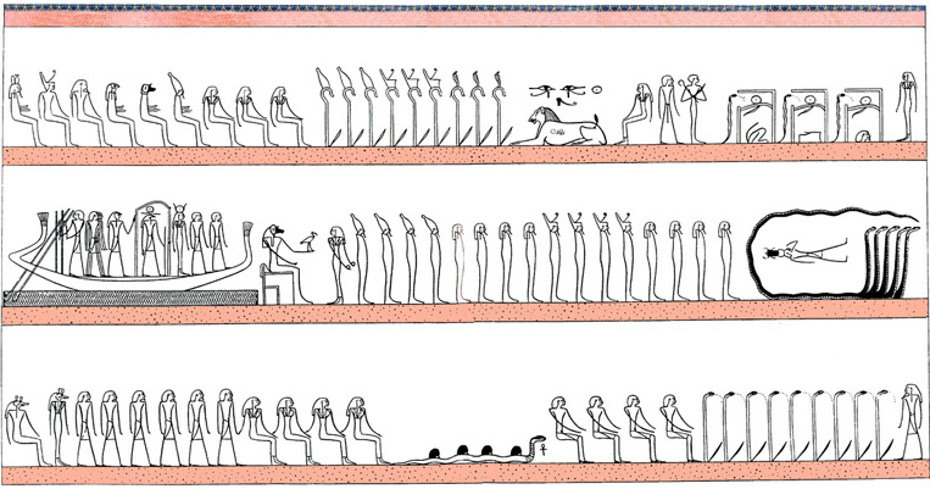
Book of the Hidden Chamber, Amduat Hour 6. Burial chamber of the tomb of Pharaoh Tuthmosis III - ca. 1426 BCE. Drawing by A.G. Shedid (digitally enhanced) - Hornung (1999).
11.22 The Hidden Chamber of the Amduat is the Queen's chamber
The Amduat Hour 6 introduces the idea that the regenerative powers originate from both the primordial waters of Nun and the Mehen serpent.
This 6th hour is very important, because it also perfectly separates the Grand Gallery representation (the Land of Sokar) from the inclined well (the "Water hole filled with Nun", the primordial ocean).
It is also clearly saying that Nun (the water of the well) is at the origin of the magical "regenerative" powers (the creation of the cold) :
"In the 6th Hour, the Land of Sokar is left and the water hole filled with Nun is reached."
"Nun, the primordial ocean, is the guardian of this hour."
"The 6th Hour is the "waterhole" of those in the Duat, filled with Nun, the primordial ocean and its regenerative powers, i.e. the presence of a creative potential (or Ba) within this darkness, namely : Atum."
In the previous excerpt the regenerative powers are linked to the primordial waters of Nun, and in the following excerpt, that same regenerative powers are this time linked to the Mehen serpent : "In the sixth hour the most significant event in the underworld occurs. The ba (or soul) of Ra unites with his own body within the circle formed by the Mehen serpent. This event is the point at which the sun begins its regeneration".
But the previous excerpts are also linking the regenerative powers (the cold) to Atum, and we've already seen that Atum was the representation of the small amount of pressurized water ejected from the inclined well towards the fog nozzle. Atum created the fog of microdroplets (represented by Tefnut, the god of humidity and moisture), and was simultaneously accompanied with fresh dry and warm air (represented by Shu, the god of dry and warm air and fog).
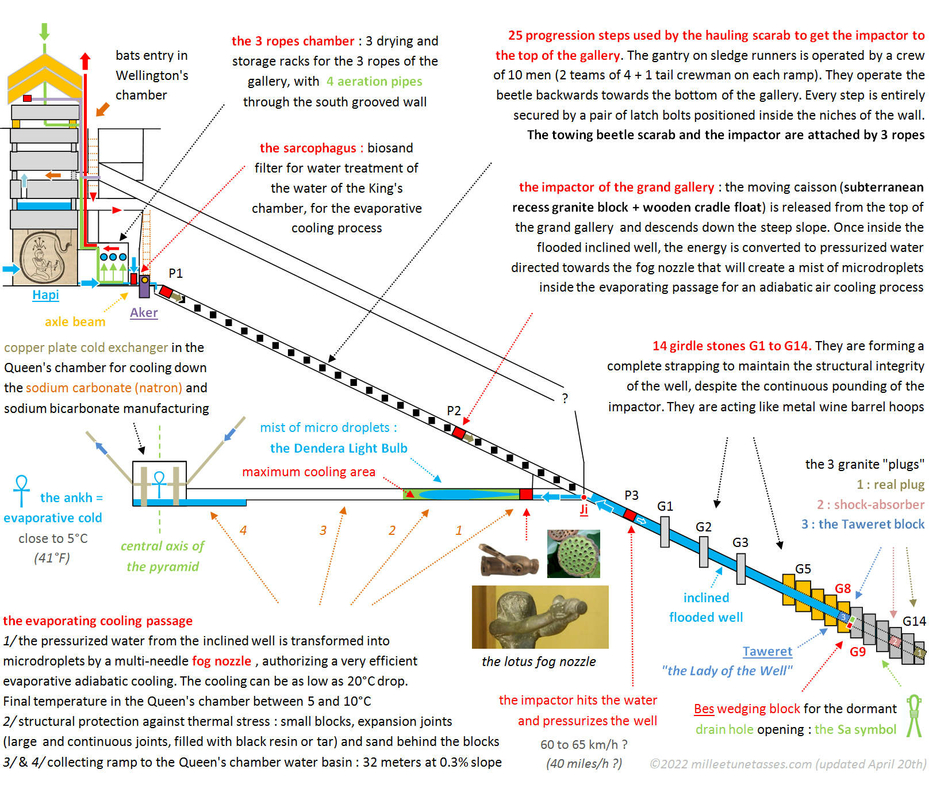
Diagram of the Great Pyramid of Giza in operation, before the shutdown procedure and the draining of the inclined well.
11.23 Summary of the study : hidden behind the academic vision of the ancient Egyptian religion, a vast number of metaphors are describing some of the most advanced science and technological knowledge of that time : ancient Egyptian gods were nothing else than pharaohs' metaphoric self-glorifications of their theoretical and experimental scientific accomplishments in physics and chemistry.
Pharaohs used the power of Science to legitimate themselves as kings of Egypt : they forged an entire religion, based on science to rule their kingdom, and they presented that science as Magic.
The end game of this technological program that probably started on the very first Dynasty, was the Great Pyramid of Giza where evaporative cooling was engineered in the known part of the pyramid from the pressurized water produced in the inclined well, known today as the ascending passage.
The evaporative cold simply took advantage of the power of water, and was most probably necessary to cool down chemical manufacturing of sodium carbonate and sodium bicarbonate produced by an ammonia-soda Solvay process, as suggested by the very strong ammonia smell and the limestone kiln in the so-called burial chamber of the Red Pyramid. At that time, sodium carbonate was called natron, and it was the salt used for the mummification of the pharaohs (Sections 14, 15 and 16).
The cooling seems to have represented the most difficult part of the process, as suggested by the Step Pyramid's official name : according to scholars, the very first pyramid complex, the Step Pyramid of Djoser, was called "the refreshment of the Gods". No doubt that a more accurate translation would certainly be "the cooling of the Gods".
It means that ancient Egyptians were the first civilization to master a Solvay-like process for sodium carbonate manufacturing, long before it got reinvented in the 1800's in Europe. The key elements of that process is the temperature control of the chemical reactions (the cooling), and the dome shaped plate necessary for the counterflow chemical reactions to occur in an efficient way. That counterflow reaction plate is what really is the disc of Sabu.
As shown with Akhenaten and Nefertiti, the creation of the evaporative cold was the most sacred accomplishment of all (Section 17), and this is exactly what the Dendera Light is all about : the Dendera Light is the fog of microdroplets of liquid water that evaporates and creates the cold. Talking about the snake inside the Dendera Light Bulb : "The field surrounding Ra’s snake form is referred to in ancient Egyptian literature as protective magical energy in liquid form that all gods and pharaohs possess" (Faulkner, Section 2).
Everything that had been done in the Great Pyramid of Giza inspired most of the ancient Egyptian religion, and it had been glorified into what we know today as the Underworld.
The Underworld is referring to the chambers and passages of the Great Pyramid of Khufu, and in particular to the Grand Gallery where a hauling gantry beetle operated a wooden coffin shaped impactor that had a small nested granite block inside it. The impactor generated endlessly, over and over, maybe every 15 minutes the pressurized water that was then transformed into a fog of microdroplets inside the horizontal cooling passage.
The Grand Gallery of the Great Pyramid where the act of hauling was done, is the "Secret Hauling Cavern of the Underworld" described in the Amduat "Book of the Hidden Chamber".
The most important chamber of the Great Pyramid wasn't the King's chamber that only was the main water tank of the pyramid, but the Queen's chamber, the only one on the central axis of the pyramid. Because the Queen's chamber was inaccessible from the rest of the pyramid, it was glorified into the "Hidden Chamber of the Underworld" (Section 11), and because the Queen's chamber was the coolest place in the pyramid (about 5°C / 41°F), and with a constant 100% Humidity rate, this chamber was the one where the biggest amount of very hard salt encrustation had been documented by the first explorers of the pyramid in the 1800's and before it had been removed in 1998 by Zahi Hawass (Section 1). Very hard salt encrustation is the signature of the evaporative cooling process, even nowadays.
The most incredible thing is that pretty much everything I've just said, actually appears in one single myth, but it doesn't originate from ancient Egypt : it is the "Churning of the Ocean" Hindu myth that produces the immortal nectar Amrita. The fact is that the endless churning of water that ends up with the production of an elixir that gives eternal life, is exactly what were doing ancient Egyptians in the inclined well : natron was the salt used for the mummification of pharaohs.
Natron gave eternal life to pharaohs, just like the Amrita (Section 19).
Poster un commentaire

